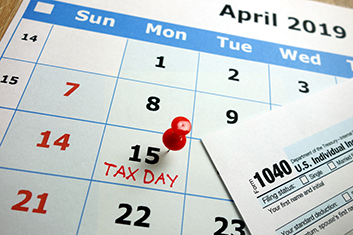This year is a little more challenging
 With tax season now officially underway, here are several tax documents that may be easy to miss in your mailbox or inbox:
With tax season now officially underway, here are several tax documents that may be easy to miss in your mailbox or inbox:
Child tax credit letter. From July through December 2021, the IRS paid out 50% of projected child tax credit payments to qualified households. The IRS is sending out a recap of these advance payments in Letter 6419 that you can use to correctly account for these payments on your tax return. This letter should have arrived in your mailbox by late January.
Updated info – The IRS alerted a small group of taxpayers that their Letter 6419 may have an incorrect dollar amount. If you believe your Letter 6419 might not be accurate, confirm the dollar amount by using your online account at IRS.gov.
Stimulus payment letter. The IRS issued millions of economic impact payments in 2021. The IRS is mailing a summary of these payments you received in Letter 6475. As with the child tax credit letter, you can use this letter to accurately report your economic impact payments on your tax return. This letter also should have arrived in your mailbox by late January.
Identification PIN. The IRS may have assigned you an Identity Protection PIN (IP PIN) to help protect your identity. An IP PIN is a six-digit number that prevents someone else from filing a tax return using your Social Security number or Individual Taxpayer Identification Number. This IP PIN is known only to you and the IRS. If you are a confirmed victim of tax-related identity theft and the IRS has resolved your tax account issues, the IRS will mail you a CP01A Notice with your new IP PIN each year.
Corrected tax forms. If an error is discovered on a tax form you’ve already received, a corrected version will be created, then mailed to both you and the IRS. You can also request a corrected tax form if you believe you found an error. Here are some of the forms you might see with corrections:
- Form W-2 from your employer that shows corrected wages, salary and taxes withheld
- Form 1099-INT or Form 1099-DIV from your investment broker that shows a revision in interest and dividend income
- Form 1099-NEC from a client to whom you provide services
- Form 1098 that shows how much mortgage or student loan interest you’ve paid
You may not be aware you were issued a corrected tax form until it shows up in your mailbox (or inbox). If you do receive a corrected form, don’t throw the old version away! Save both the original version and corrected version in case either are needed for future reference.
Often the ease of filing your tax return is dependent on having the correct information, so remember to look for everything, including these often-overlooked forms.
Here are four ways to make sure the preparation of your tax return keeps humming along until it gets filed.
- Keep tax documents in one place. Missing items are one of the biggest reasons filing a tax return gets delayed! Find a place in your home and put all tax documents in this one place as you receive them. Common missing items this year will include the new 1099-NEC for any taxpayers that are contractors, consultants or part of the gig economy.
- Organize documents by type. Every tax professional has a story of someone bringing their documents to them in a shoebox or storage container. All this does is increase the amount of time it takes to prepare your return, so it’s best to sort your documents in tax return order. Pull out last year’s tax return and create folders for each section including income, business/rental information, adjustments to income, itemized deductions, tax credit information and a not-sure bucket.
- Create list of special events. You receive a Form W-2 from your employer every year. You may get a 1099-INT from your bank if you earn interest income on your deposit accounts. But selling a home usually doesn’t happen every year. Retiring from a 40-year job doesn’t happen every year. Sending a child to college also doesn’t happen every year (although it might seem like it does!). If you don’t write down these unusual events as they happen, you might forget them when your tax return is being prepared. And you may not remember until the moment your return is about to be filed. This is sure to cause delays.
- Don’t forget your signature! You may be surprised to learn that even if you electronically file your tax return, you still must sign Form 8879, which authorizes the e-filing of your return. So, whether it’s a traditionally-filed paper tax return or one filed electronically, a signature is required.
 These are four of the more common reasons why the preparation of your tax return may get delayed. Be prepared and file your return without a hitch!
These are four of the more common reasons why the preparation of your tax return may get delayed. Be prepared and file your return without a hitch!
Handling employment taxes can be complicated, especially when you’re required to file important tax documents throughout the year. Here’s a list of key forms and deadline dates to help keep you on track.
Form 941 — Employer’s quarterly federal tax return
This form is used to report income tax withheld from employees’ pay and both the employer’s and employees’ share of Social Security and Medicare taxes.
Employers generally must deposit Form 941 payroll taxes on either a monthly or semiweekly deposit schedule. There are exceptions if you owe $100,000 or more on any day during a deposit period, if you owe $2,500 or less for the calendar quarter, or if your estimated annual payroll tax liability is $1,000 or less.
- Monthly depositors are required to deposit payroll taxes accumulated within a calendar month by the 15th of the following month.
- Semiweekly depositors generally must deposit payroll taxes on Wednesdays or Fridays, depending on when wages are paid.

Return filing deadlines:
- Jan. 31, 2020 – Due date for filing Form 941 for the fourth quarter of 2019. If you deposited your taxes in full and on time, you have until Feb. 10, 2020, to file this return.
- April 30, 2020 – Due date for filing Form 941 for the first quarter. If you deposited your taxes in full and on time, you have until May 11, 2020, to file this return.
- July 31, 2020 – Due date for filing Form 941 for the second quarter. If you deposited your taxes in full and on time, you have until Aug. 10, 2020, to file this return.
- Nov. 1, 2020 – Due date for filing Form 941 for the third quarter. If you deposited your taxes in full and on time, you have until Nov. 10 to file this return.
Form 940 — Employer’s annual federal unemployment tax return (FUTA)
This return is due annually. However, FUTA tax must generally be deposited once a quarter if the accumulated tax exceeds $500.
- Jan. 31, 2020 – Due date for filing 2019 Form 940. If you deposited your taxes in full and on time, you have until Feb. 10, 2020, to file this return. This day is also the deadline for depositing federal unemployment tax for October, November and December 2019.
- April 30, 2020 – Deadline for depositing federal unemployment tax for January, February and March 2020.
- July 31, 2020 – Deadline for depositing federal unemployment tax for April, May and June 2020.
- Nov. 1, 2020 – Deadline for depositing federal unemployment tax for July, August and September 2020.
Form W-2 — Wage and tax statement
Employers are required to send this document to each employee and the IRS at the end of the year. It reports employee annual wages and taxes withheld from paychecks.
- Jan. 31, 2020 – Due date for employers to provide 2019 Forms W-2 to employees, and for employers to send copies of 2019 W-2s to the Social Security Administration, whether filing electronically or with paper forms.
Tax deadline extensions for disaster areas
For taxpayers living in designated disaster areas, the IRS extends certain filing and tax payment dates. Taxpayers living in the affected areas (and those whose tax professionals are located in those areas) have relief from penalties for filing under the new extended dates. These filing and payment extensions are also available to some relief workers.
Visit the IRS’s Disaster Assistance and Emergency Relief for Individuals and Businesses page for up-to-date information.
 In 2018, the government attempted to “simplify” the tax-filing process by drastically shortening Form 1040. The result was six new schedules that created a lot of confusion. Now the IRS is attempting to ease some of that pain by revising the form and removing some schedules. Will it help? Here is what you need to know:
In 2018, the government attempted to “simplify” the tax-filing process by drastically shortening Form 1040. The result was six new schedules that created a lot of confusion. Now the IRS is attempting to ease some of that pain by revising the form and removing some schedules. Will it help? Here is what you need to know:
- More information on the main form. To make it easier for the IRS to match pertinent information across related tax returns, new fields have been added on the main Form 1040. For example, there’s now a spot for your spouse’s name if you choose the married filing separate status. In addition, there’s a separate line for IRA distributions to more clearly differentiate retirement income.
- 3 schedules are gone. What was your favorite memory of Schedules 4, 5 and 6? Was it the unreported Social Security tax on Schedule 4? Or the credit for federal fuels on Schedule 5? While those schedules will no longer exist, those lines (and many others) have found a new home on one of the first three schedules. Less paperwork, but still the same amount of information.
- You can keep your pennies! For the first time, the IRS is eliminating the decimal spaces for all fields. While reporting round numbers has been common practice, it’s now required.
- Additional changes on the way. The current versions of Form 1040 and Schedules 1, 2 and 3 are in draft form and awaiting comments on the changes. Because of the importance of the 1040, the IRS is expecting to make at least a few updates in the coming weeks (or months) before they consider it final. Stay tuned for more developments.
How to prepare for the changes
The best way to prepare is to be aware that 1040 changes are coming. The information required to file your taxes will remain the same, but some additional hunting will be necessary to find the shifting lines and fields on the modified form.
Remember, changes bring uncertainty and potential for delays, so getting your tax documents organized as early as possible will be key for a timely tax-filing process.
Make things easier on yourself with a few quick steps you can take now to help cut down on tax season stress. Here are a few suggestions:
Plan to organize early. Set aside a folder to collect what you’ll need:
- W-2’s from your employer
- 1099’s for other income earned
- Bank and other financial statements
- Receipts for things like medical bills and charitable donations
- Childcare information and your dependents’ income
- If you’ve refinanced or bought a new home – we need those docs, too!
A tax meeting is not necessary if there have been no major changes within the last year. However, if you feel you do need a tax meeting, please contact our office early to schedule an appointment. My schedule fills up fast!